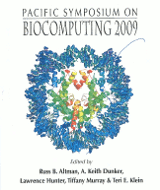Pairwise Alignment of Interaction Networks by Fast Identification of Maximal Conserved Patterns
Wenhong Tian1,2 and Nagiza F. Samatova1,2
1Department of Computer and Mathematics Division , Oak Ridge National Laboratory, Oak Ridge, TN 37831, USA; 2Computer Science Department, North Carolina State University, Raleigh, NC 27696, USA
Email: wenhong_tian@hotmail.com
Pacific Symposium on Biocomputing 14:99-110(2009)

Abstract
A number of tools for the alignment of protein-protein interaction (PPI) networks have laid the foundation for PPI network analysis. They typically find conserved interaction patterns by various local or global search algorithms, and then validate the results using genome annotation. The improvement of the speed, scalability and accuracy of network alignment is still the target of ongoing research. In view of this, we introduce a connected-components based algorithm, called HopeMap for pairwise network alignment with the focus on fast identification of maximal conserved patterns across species. Observing that the number of true homologs across species is relatively small compared to the total number of proteins in all species, we start with highly homologous groups across species, find maximal conserved interaction patterns globally with a generic scoring system, and validate the results across multiple known functional annotations. The results are evaluated in terms of statistical enrichment of gene ontology (GO) terms and KEGG ortholog groups (KO) within conserved interaction patters. HopeMap is fast, with linear computational cost, accurate in terms of KO groups and GO terms specificity and sensitivity, and extensible to multiple network alignment.
[Full-Text PDF] [PSB Home Page]